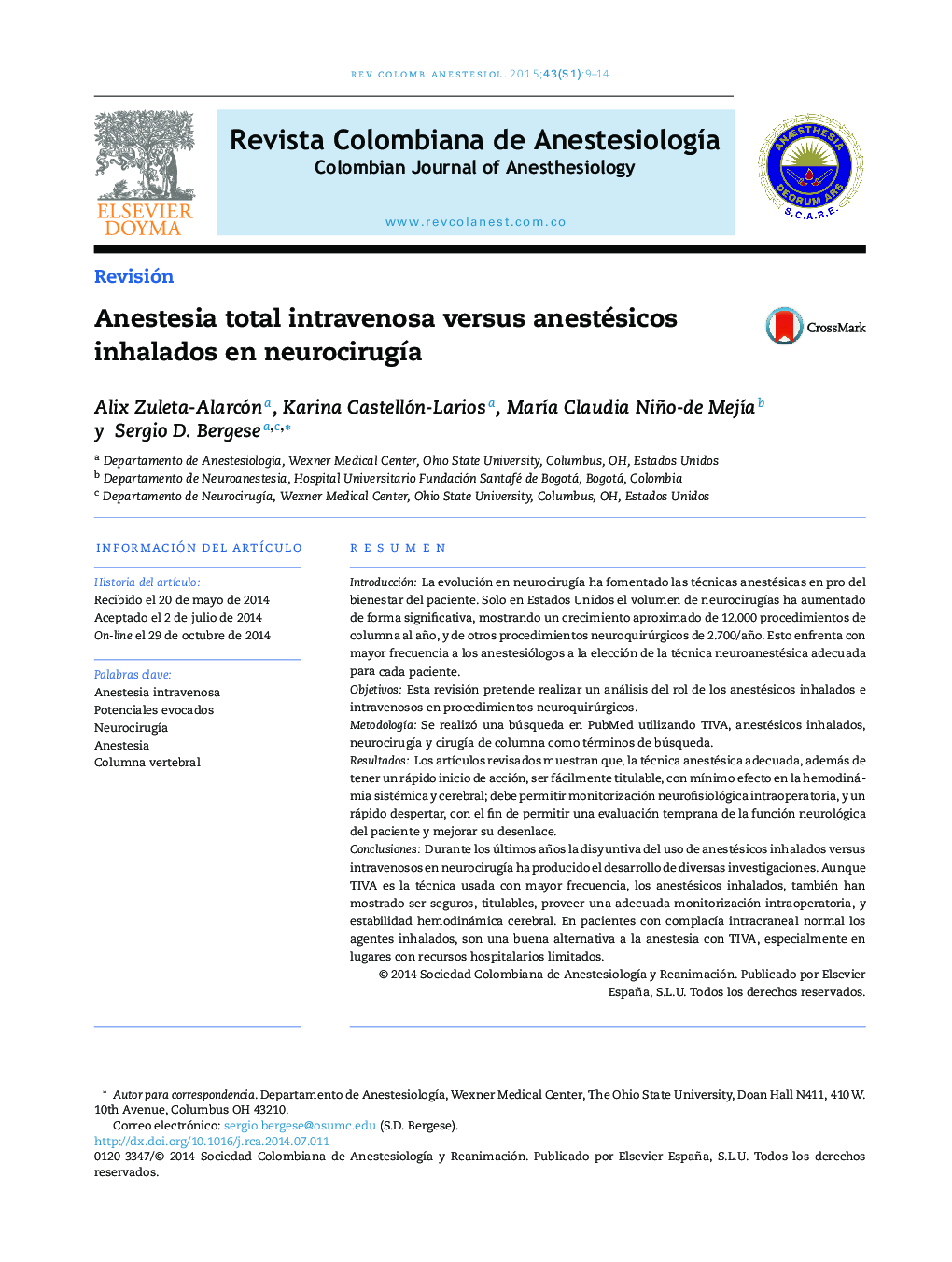| کد مقاله | کد نشریه | سال انتشار | مقاله انگلیسی | نسخه تمام متن |
|---|---|---|---|---|
| 2767652 | 1151207 | 2015 | 6 صفحه PDF | دانلود رایگان |

ResumenIntroducciónLa evolución en neurocirugía ha fomentado las técnicas anestésicas en pro del bienestar del paciente. Solo en Estados Unidos el volumen de neurocirugías ha aumentado de forma significativa, mostrando un crecimiento aproximado de 12.000 procedimientos de columna al año, y de otros procedimientos neuroquirúrgicos de 2.700/año. Esto enfrenta con mayor frecuencia a los anestesiólogos a la elección de la técnica neuroanestésica adecuada para cada paciente.ObjetivosEsta revisión pretende realizar un análisis del rol de los anestésicos inhalados e intravenosos en procedimientos neuroquirúrgicos.MetodologíaSe realizó una búsqueda en PubMed utilizando TIVA, anestésicos inhalados, neurocirugía y cirugía de columna como términos de búsqueda.ResultadosLos artículos revisados muestran que, la técnica anestésica adecuada, además de tener un rápido inicio de acción, ser fácilmente titulable, con mínimo efecto en la hemodinámia sistémica y cerebral; debe permitir monitorización neurofisiológica intraoperatoria, y un rápido despertar, con el fin de permitir una evaluación temprana de la función neurológica del paciente y mejorar su desenlace.ConclusionesDurante los últimos años la disyuntiva del uso de anestésicos inhalados versus intravenosos en neurocirugía ha producido el desarrollo de diversas investigaciones. Aunque TIVA es la técnica usada con mayor frecuencia, los anestésicos inhalados, también han mostrado ser seguros, titulables, proveer una adecuada monitorización intraoperatoria, y estabilidad hemodinámica cerebral. En pacientes con complacía intracraneal normal los agentes inhalados, son una buena alternativa a la anestesia con TIVA, especialmente en lugares con recursos hospitalarios limitados.
IntroductionThe way neurosurgery has evolved has led to increased emphasis on anaesthetic techniques aimed at improving patient well-being. In the United States alone, the number of neurosurgeries has increased significantly, with growth reflected in approximately 12,000 spine procedures per year and another 2700 different neurosurgical procedures per year. For anaesthetists, this means that they are faced more frequently with the need to select the most adequate neuroanaesthesia technique for each patient.ObjectivesThe purpose of this review is to analyze the role of inhaled and intravenous anaesthetics in neurosurgical procedures.MethodologyA search was conducted in PubMed using the terms TIVA, inhaled anaesthetics, neurosurgery and spine surgery.ResultsThe articles included in the review show that the adequate anaesthetic technique, besides ensuring a rapid onset of action, contributes to ease of titration with minimum effect on systemic and cerebral haemodynamics; it must enable intraoperative neurophysiological monitoring and rapid emergence, in order to allow early assessment of the patient's neurological function and improved outcome.ConclusionsIn recent years, the question regarding the use of inhaled vs. intravenous anaesthetics in neurosurgery has given rise to several research studies. Although TIVA is the technique used most frequently, inhaled anaesthetics have also been shown to be safe, titratable, and to provide for adequate intraoperative monitoring and cerebral haemodynamic stability. In patients with normal intracranial compliance, inhaled agents (IA) are a good alternative to TIVA, especially in places where hospital resources are limited.
Journal: Revista Colombiana de Anestesiología - Volume 43, Supplement 1, January–March 2015, Pages 9–14